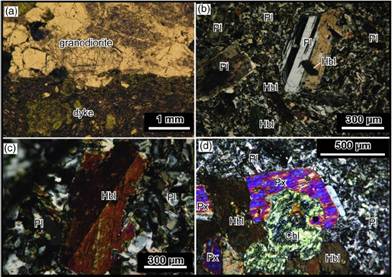Tracing A Subducted Ridge–Transform System in A Late Carboniferous Accretionary Prism of the Southern Altaids Orthogonal Sanukitoid Dyke Swarms in Western Junggar
2012-06-05
Ridge–trench interaction is one of the prominent mechanisms of Circum-Pacific subduction systems, and the geometrical configuration of a subducted ridge–transform system is a leading factor controlling ridge–trench interaction in any given subduction zone. In particular, pre-subduction ridge–transform–trench geometry exerts the principal control on the shape and size of a slab window, and different incident angles of a ridge with a trench would induce different triple junction migration rates along the trench, and would even cause a triple junction to move back and forth in some cases. Figuring out the configuration of a ridge subduction system and identifying a triple junction could help outline the framework of the physical, chemical and thermal characteristics of a region and its geology.
Dyke swarms can be used as a powerful tool in rebuilding paleogeographic tectonic regimes, such as the determination of subduction azimuth and dip. Crucially, mantle-derived dyke swarms can provide information on extensional processes in the lithosphere. Therefore, researchers selected two critical areas in order to map over 220 dykes in two major swarms from which seven samples were collected for geochemical and isotopic analyses. This research aims to use structural, geochemical and isotopic data to demonstrate that the dyke swarms in Western Junggar were formed by Late Carboniferous ridge subduction, and to discuss the role of dyke swarms in reconstructing the configuration of ancient subduction–accretion systems.
Two sets of Late Paleozoic, orthogonal, dioritic dyke swarms are defined in the eastern part of the Western Junggar accretionary collage in the southern Altaids. Dioritic dykes (hornblende+plagioclase) are characterized by relatively high SiO2, elevated MgO, Na2O, K2O, Mg#, Ni, Si and Cr contents, La/Yb ratios, very low Y contents, and enrichments in large ion lithophile elements (LILE) and light rare earth elements (LREE), which are all comparable with those of sanukitoids. These dioritic dykes have low (87Sr/86Sr) ratios (mostly between 0.70366 and 0.70381) and high positive εNd (t) (+6.6 to +8.4) values, suggesting they were sourced from a depleted mantle. Accordingly, these dioritic dykes were probably derived by mixing of depleted mantle components that originated from upwelling of asthenosphere through a slab window with melts that were derived by dehydration of a subducted slab. Detailed mapping and structural data of the dyke swarms indicate that the NW/SE-trending set was earlier than the NE/SW-trending dykes.
Paleostress analysis and inversion of the dyke swarms indicate that an early NE/SW-extension was associated with a NW/SE-trending slab window, and was followed by a slightly later NW/SE-extension that was associated with a NE/SW-trending slab window. Field relationships, together with published age constraints, suggest that these two dyke swarms were intruded in the Late Carboniferous. Therefore two orthogonal slab windows were opened, one (NE-SW) after the other (NW-SE) during this time period. A subducted ridge–transform system could well account for and is consistent with these relationships. Researchers propose that in the Late Carboniferous a NW/SE-trending mid-oceanic ridge was subducted beneath the Darbut trench generating large-scale, closely spaced NW/SE-trending dykes that were intruded through a slab window. That event was followed by subduction of a NE/SW-trending transform fault (fracture zone) that connected with the earlier NW/SE-trending ridge, producing widely spaced NE/SW-trending dykes that were intruded through a NE/SW-trending vertical slab window. This new approach to the relationships between dyke swarms, adakitic/sanukitoid magmatism, ridge subduction and slabwindows has broad implications for tectonic reconstruction of ancient accretionary orogens.
Main findings of this study have been published on Lithos, 2012, 140-141: 152-165. The paper is also archived at http://www.sciencedirect.com/science/article/pii/S0024493712000497.

Fig. (a) Photomicrograph in single-polarized light, showing the details of the contact between a dyke and its host granodiorite. (b), (c) and (d) Mineral assemblages of a dioritic dyke, in cross-polarized light. Hbl = hornblende, Pl = plagioclase, Px = pyroxene, and Chl = chlorite. (Image by XIEG)



